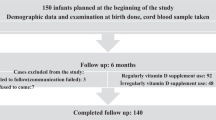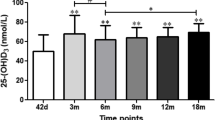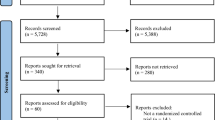Abstract
Background
Hypovitaminosis D is prevalent during pregnancy and may affect fetal brain development, leading to neurocognitive issues. This study investigated the association between vitamin D levels during pregnancy and children’s neurocognitive functioning in 289 mother-child pairs, controlling for confounding variables.
Methods
Prenatal serum 25-hydroxyvitamin D (25(OH)D) concentrations were measured in the first and third trimesters, and offspring underwent a neurocognitive assessment at age 4 using the Wechsler Preschool and Primary Scale of Intelligence—Fourth Edition (WPPSI-IV), subtests of the Developmental Neuropsychological Assessment-II (NEPSY-II), and the Behavior Rating Inventory of Executive Function—Preschool Version (BRIEF-P) completed by parents. Socio-demographic data, obstetric information, lifestyle habits, maternal emotional health, and parental intellectual performance were collected.
Results
The adjusted regression models have shown that insufficient 25(OH)D levels throughout pregnancy were associated with poorer Visual-Motor Precision of the NEPSY-II. In the third trimester, inadequate 25(OH)D levels were associated with poorer executive functioning, as indicated by neuropsychological and behavioural assessments. Specifically, lower scores were observed in Working Memory on the WPPSI-IV, as well as in the metacognitive index and Inhibition on the BRIEF-P.
Conclusion
Maintaining adequate prenatal 25(OH)D levels may promote optimal neurocognitive functioning in early childhood.
Impact
-
Inadequate maternal 25(OH)D concentrations throughout pregnancy are associated with lower Visual-Motor Precision in children, and third-trimester deficiency is linked to poorer executive functioning.
-
This study highlights the importance of maintaining adequate vitamin D levels throughout pregnancy.
-
Findings support the implementation of public health strategies to ensure proper vitamin D intake and the monitoring of maternal serum 25(OH)D levels during pregnancy to promote adequate infant neurodevelopment.
This is a preview of subscription content, access via your institution
Access options
Subscribe to this journal
Receive 14 print issues and online access
$259.00 per year
only $18.50 per issue
Buy this article
- Purchase on SpringerLink
- Instant access to full article PDF
Prices may be subject to local taxes which are calculated during checkout
Similar content being viewed by others
Data availability
The datasets analysed during the current study are not publicly available due to ethical and legal restrictions, but are available from the corresponding author on reasonable request.
References
Cashman, K. D. Vitamin D deficiency: defining, prevalence, causes, and strategies of addressing. Calcif. Tissue Int. 106, 14–29 (2020).
Meija, L. et al. Vitamin D intake and serum levels in pregnant and postpartum women. Nutrients 15, 3493 (2023).
Llopis, M. et al. Sociodemographic, lifestyle, and environmental determinants of vitamin D levels in pregnant women in Spain. Environ. Int. 182, 108293 (2023).
Saraf, R., Morton, S. M., Camargo, C. A. Jr & Grant, C. C. Global summary of maternal and newborn vitamin D status—a systematic review. Matern. Child Nutr. 12, 647–668. https://doi.org/10.1111/mcn.12210 (2016).
Institute of Medicine (US) Committee. Overview of vitamin D. In: Ross, A. C., Taylor, C. L., Yaktine, A. L. & Del Valle, H. B. (eds.) Dietary reference intakes for calcium and vitamin D. Washington, DC: National Academies Press (2011). https://doi.org/10.17226/13050
Chen, B., Chen, Y., Xu, Y. & Cicero, A. Vitamin D deficiency in pregnant women: influenced by multiple risk factors and increases the risks of spontaneous abortion and small-for-gestational age. Medicine 100, e27505 (2021).
Chien, M. C., Huang, C. Y., Wang, J. H., Shih, C. L. & Wu, P. Effects of vitamin D in pregnancy on maternal and offspring health-related outcomes. Umbrella Rev. Syst. Rev. Meta Analyses. Nutr. 14, 35 (2024).
Mansur, J. L., Oliveri, B., Giacoia, E., Fusaro, D. & Costanzo, P. R. Vitamin D: before, during and after pregnancy: effect on neonates and children. Nutrients 14, 1900 (2022).
Urrutia-Pereira, M. & Solé, D. V. itaminD. deficiency in pregnancy and its impact on the fetus, the newborn and in childhood. Rev. Paul. Pediatr. 33, 104 (2015).
Lisi, G., Ribolsi, M., Siracusano, A. & Niolu, C. Maternal vitamin D and its role in determining fetal origins of mental health. Curr. Pharm. Des. 26, 2497–2509 (2020).
Larqué, E., Morales, E., Leis, R. & Blanco-Carnero, J. E. Maternal and foetal health implications of vitamin D status during pregnancy. Ann. Nutr. Metab. 72, 179–192 (2018).
Janbek, J., Specht, I. O. & Heitmann, B. L. Associations between vitamin D status in pregnancy and offspring neurodevelopment: a systematic literature review. Nutr. Rev. 77, 330–349 (2019).
Morales, E. et al. Circulating 25-hydroxyvitamin D₃ in pregnancy and infant neuropsychological development. Pediatrics 130, e913–e920 (2012).
Voltas, N. Effect of vitamin D status during pregnancy on infant neurodevelopment: the ECLIPSES study. Nutrients 12, 3196 (2020).
Zhang, Y. et al. Maternal and neonatal blood vitamin D status and neurodevelopment at 24 months of age: a prospective birth cohort study. World J. Pediatr. 19, 883–893 (2023).
Cantio, E. et al. Vitamin D status in pregnancy and childhood associates with intelligence quotient at age 7 years: an Odense child cohort study. Aust. N. Z. J. Psychiatry 57, 1062–1072 (2023).
Melough, M. et al. Maternal plasma 25-hydroxyvitamin D during gestation is positively associated with neurocognitive development in offspring at age 4–6 years. J. Nutr. 151, 132–139 (2021).
Shekhawat, D. S. et al. Prenatal vitamin D levels and infant cognitive, motor, language and social-emotional development at 6 and 9 months of age. Nutr. Neurosci. 28, 263–272 (2025).
Brouwer-Brolsma, E. M., Vrijkotte, T. G. M. & Feskens, E. J. M. Maternal vitamin D concentrations are associated with faster childhood reaction time and response speed, but not with motor fluency and flexibility, at the age of 5–6 years: the Amsterdam Born Children and their Development (ABCD) Study. Br. J. Nutr. 120, 345–352 (2018).
Darling, A. L. et al. Association between maternal vitamin D status in pregnancy and neurodevelopmental outcomes in childhood: results from the Avon Longitudinal Study of Parents and Children (ALSPAC). Br. J. Nutr. 117, 1682–1692 (2017).
Gould, J. F. et al. Association of cord blood vitamin D with child neurodevelopment at 7 years of age. J. Paediatr. Child Health 60, 312–322 (2024).
Laird, E. et al. Maternal vitamin D status and the relationship with neonatal anthropometric and childhood neurodevelopmental outcomes: results from the Seychelles Child Development Nutrition Study. Nutrients 9, 1235 (2017).
Veena, S. R. et al. Association between maternal vitamin D status during pregnancy and offspring cognitive function during childhood and adolescence. Asia Pac. J. Clin. Nutr. 26, 438 (2017).
Arija, V. et al. Adapting iron dose supplementation in pregnancy for greater effectiveness on mother and child health: protocol of the ECLIPSES randomized clinical trial. BMC Pregnancy Childbirth 14, 1–10 (2014).
Hollingshead, A. B. Four-factor index of social status. Yale J. Sociol. 8, 21–52 (2011).
Heatherton, T. F., Kozlowski, L. T., Frecker, R. C. & Fagerström, K. O. The Fagerström Test for Nicotine Dependence: a revision of the Fagerström Tolerance Questionnaire. Br. J. Addict. 86, 1119–1127 (1991).
Trinidad Rodríguez, I., Fernández Ballart, J., Cucó, G., Biarnés Jordà, E. & Arija Val, V. Validación de un cuestionario de frecuencia de consumo alimentario corto: reproducibilidad y validez. Nutr. Hosp. 23, 242–252 (2008).
Trichopoulou, A., Costacou, T., Bamia, C. & Trichopoulos, D. Adherence to a Mediterranean diet and survival in a Greek population. N. Engl. J. Med. 348, 2599–2608 (2003).
Buela-Casal, G., Guillen-Riquelme, A. & Seisdedos Cubero, N. Cuestionario de ansiedad estado-rasgo: Adaptación española. (TEA Ediciones, 2011).
Spielberger, C. D., Gorsuch, R. L. & Lushene, R. E. Cuestionario de ansiedad estado-rasgo. (TEA Ediciones, 1988).
Goldberg, D. P. et al. The validity of two versions of the GHQ in the WHO study of mental illness in general health care. Psychol. Med. 27, 191–197 (1997).
Wechsler, D. WAIS-IV: Escala de Inteligencia de Wechsler para Adultos—Cuarta edición. Manual técnico y de interpretación. (NCS Pearson, Inc., 2012). [Original work published 2008].
Esteban-Figuerola, P., Jardí, C., Canals, J. & Arija, V. Validation of a short food frequency questionnaire in small children. Nutr. Hosp. 37, 101–113 (2020).
Norte Navarro, A. I. & Ortiz Moncada, R. Calidad de la dieta española según el índice de alimentación saludable. Nutr. Hosp. 26, 330–336 (2011).
Sociedad Española de Nutrición Comunitaria. Guía de la alimentación saludable. Madrid (2004).
Wechsler, D. WPPSI-IV: Escala de Inteligencia de Wechsler para la Edad Preescolar y Primaria—Cuarta edición. Manual técnico y de interpretación. (NCS Pearson, Inc., 2014). [Original work published 2012].
Korkman, M., Kirk, U. & Kemp, S. NEPSY: A Developmental Neuropsychological Assessment (2nd ed.). (The Psychological Corporation, 2007).
Korkman, M., Kirk, U. & Kemp, S. NEPSY-II. (NCS Pearson, 2014).
Gioia, G. A., Espy, K. A. & Isquith, P. K. BRIEF-P. Evaluación Conductual de la Función Ejecutiva—Versión Infantil (Bausela, E. & Luque, T., eds). (TEA Ediciones, 2016). Disponible en: https://web.teaediciones.com.
Rubin, D. B. Multiple Imputation for Nonresponse in Surveys. (Wiley, 1987).
Gunton, J. E., Girgis, C. M., Baldock, P. A. & Lips, P. Bone muscle interactions and vitamin D. Bone 80, 89–94 (2015).
Kolk, S. M. & Rakic, P. Development of prefrontal cortex. Neuropsychopharmacology 47, 41–57 (2022).
Eyles, D. W., Smith, S., Kinobe, R., Hewison, M. & McGrath, J. J. Distribution of the vitamin D receptor and 1α-hydroxylase in human brain. J. Chem. Neuroanat. 29, 21–30 (2005).
Annweiler, C. et al. Meta-analysis of memory and executive dysfunctions in relation to vitamin D. J. Alzheimers Dis. 37, 147–171 (2013).
Redlich, D., Schommer, L., Krüger, K. & Raab, M. The association between vitamin D and executive functions in healthy young- and middle-aged adults: a scoping review. J. Cogn. Enhanc. 8, 1–11 (2024).
Turner, K. M., Young, J. W., McGrath, J. J., Eyles, D. W. & Burne, T. H. J. Cognitive performance and response inhibition in developmentally vitamin D (DVD)-deficient rats. Behav. Brain Res. 242, 47–53 (2013).
Hawes, J. E. et al. Maternal vitamin D deficiency alters fetal brain development in the BALB/c mouse. Behav. Brain Res. 286, 192–200 (2015).
Chu, S. H. et al. Circulating levels of maternal vitamin D and risk of ADHD in offspring: results from the Vitamin D Antenatal Asthma Reduction Trial. Int. J. Epidemiol. 51, 910–918 (2022).
Tirani, S. A., Balali, A., Askari, G. & Saneei, P. Maternal serum 25-hydroxy vitamin D levels and risk of autism spectrum and attention-deficit hyperactivity disorders in offspring: a systematic review and dose–response meta-analysis. Psychiatry Res. 319, 114977. https://doi.org/10.1016/j.psychres.2022.114977 (2023).
Shah, V. P. et al. A systematic review supporting the Endocrine Society clinical practice guidelines on vitamin D. J. Clin. Endocrinol. Metab. 109, 1961–1974 (2024).
Acknowledgements
We thank the entities and participants involved in the ECLIPSES study, the personnel of the Research Group in Nutrition and Mental Health (NUTRISAM), the Sexual and Reproductive Health Care Services (ASSIR) of Tarragona (Spain), the Institut d’Atenció Primària IDIAP Jordi Gol, and the Institut Català de la Salut, Barcelona (Spain). This work was financially supported by the Instituto de Salud Carlos III, Fondo de Investigación Sanitaria, Ministerio de Sanidad y Consumo [grant numbers PI12/02777 and PI17/01574] and co-funded by the European Regional Development Fund (ERDF).
Author information
Authors and Affiliations
Contributions
All authors contributed substantially to the conception and design of the study, acquisition of data, analysis and interpretation of data, drafting the article, and revising it critically for important intellectual content. All authors approved the final version to be published.
Corresponding author
Ethics declarations
Competing interests
The authors declare no competing interests.
Informed consent
Written informed consent was obtained from all participants included in this study.
Additional information
Publisher’s note Springer Nature remains neutral with regard to jurisdictional claims in published maps and institutional affiliations.
Supplementary information
Rights and permissions
Springer Nature or its licensor (e.g. a society or other partner) holds exclusive rights to this article under a publishing agreement with the author(s) or other rightsholder(s); author self-archiving of the accepted manuscript version of this article is solely governed by the terms of such publishing agreement and applicable law.
About this article
Cite this article
Voltas, N., Cendra-Duarte, E., Canals, J. et al. Vitamin D status during pregnancy and child neurocognitive functioning at 4 Years. Pediatr Res (2025). https://doi.org/10.1038/s41390-025-04258-9
Received:
Revised:
Accepted:
Published:
DOI: https://doi.org/10.1038/s41390-025-04258-9
This article is cited by
-
Prenatal vitamin D status and long-term neurocognitive outcomes: building on an emerging evidence base
Pediatric Research (2025)



